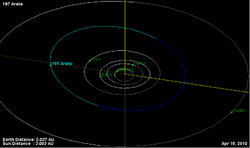Astronomy:197 Arete
From HandWiki
 Orbital diagram | |
| Discovery[1] | |
|---|---|
| Discovered by | Johann Palisa |
| Discovery date | 21 May 1879 |
| Designations | |
| (197) Arete | |
| Pronunciation | /əˈriːtiː/[2] |
| Named after | Arete |
| A879 KA; 1934 RE1; 1950 DY | |
| Minor planet category | Asteroid belt |
| Orbital characteristics[3][4] | |
| Epoch 31 July 2016 (JD 2457600.5) | |
| Uncertainty parameter 0 | |
| Observation arc | 136.89 yr (50000 d) |
| |{{{apsis}}}|helion}} | 3.1882283 astronomical unit|AU (476.95216 Gm) (Q) |
| |{{{apsis}}}|helion}} | 2.2897600 AU (342.54322 Gm) (q) |
| 2.7389941 AU (409.74769 Gm) (a) | |
| Eccentricity | 0.1640143 (e) |
| Orbital period | 4.53 yr (1655.7 d) |
| Mean anomaly | 20.361539° (M) |
| Mean motion | 0° 13m 2.744s / day (n) |
| Inclination | 8.793773° (i) |
| Longitude of ascending node | 81.607160° (Ω) |
| 246.46589° (ω) | |
| Earth MOID | 1.29448 AU (193.651 Gm) |
| Jupiter MOID | 2.16829 AU (324.372 Gm) |
| TJupiter | 3.314 |
| Physical characteristics[8] | |
| Dimensions | 29.18±2.4 km |
| Rotation period | 6.6084 h (0.27535 d)[3] 6.54 h[5] |
| Geometric albedo | 0.4417±0.083[3] 0.442[6] |
| S[7] | |
| Absolute magnitude (H) | 9.18[3] |
Arete (minor planet designation: 197 Arete) is an asteroid in the asteroid belt. It has a very bright surface, even so when compared to other rocky S-type asteroid.
It was discovered by J. Palisa on May 21, 1879, and named after Arete, the mother of Nausicaa in Homer's The Odyssey.[9] Every 18 years, this asteroid approaches within 0.04 AU of 4 Vesta. During these encounters, Vesta causes a gravitational perturbation of Arete, allowing the mass of Vesta to be directly determined.[10]
Photometric observations during 1984 showed a rotation period of 6.54 ± 0.02 hours and a brightness variation of 0.10 ± 0.01 in magnitude. The light curve shows "four well defined extrema with two asymmetric maxima".[11]
References
- ↑ "Discovery Circumstances: Numbered Minor Planets". http://cfa-www.harvard.edu/iau/lists/NumberedMPs.html.
- ↑ Benjamin Smith (1903) The Century Dictionary and Cyclopedia
- ↑ 3.0 3.1 3.2 3.3 "JPL Small-Body Database Browser: 197 Arete". Archived from the original on 21 July 2011. https://web.archive.org/web/20110721054158/http://ssd.jpl.nasa.gov/sbdb.cgi. Retrieved 2011-08-18.
- ↑ "AstDys: 197 Arete". https://newton.spacedys.com/astdys/index.php?pc=1.1.0&n=arete. Retrieved 2011-08-18.
- ↑ "Asteroid Lightcurve Data Base (LCDB) | PDS SBN Asteroid/Dust Subnode". http://sbn.psi.edu/pds/resource/lc.html.
- ↑ "Infrared Astronomical Satellite (IRAS)". Archived from the original on 2005-02-24. https://web.archive.org/web/20050224095554/http://dorothy.as.arizona.edu/DSN/IRAS/index_iras.html. Retrieved 2005-02-24.
- ↑ "Asteroid Lightcurve Data File, Updated March 1, 2001". http://spiff.rit.edu/richmond/parallax/phot/LCSUMPUB.TXT.
- ↑ "The Asteroid Orbital Elements Database". Lowell Observatory. http://ftp.lowell.edu/pub/elgb/astorb.html.
- ↑ Schmadel, Lutz D. (2003). Dictionary of minor planet names. 1 (5th ed.). Berlin Heidelberg New York: Springer-Verlag. pp. 32–33. ISBN 3-540-00238-3.
- ↑ Hertz, Hans G. (April 19, 1968). "Mass of Vesta". Science 160 (3825): 299–300. doi:10.1126/science.160.3825.299. PMID 17788233. Bibcode: 1968Sci...160..299H.
- ↑ di Martino, M.; Zappala, V.; de Campos, J. A.; Debehogne, H.; Lagerkvist, C.-I. (September 1988), "Rotational properties and lightcurves of the minor planets 94, 107, 197, 201, 360, 451, 511 and 702", Astronomy and Astrophysics Supplement Series 67 (1): 95–101, Bibcode: 1987A&AS...67...95D.
External links
- 197 Arete at AstDyS-2, Asteroids—Dynamic Site
- 197 Arete at the JPL Small-Body Database
 |

